|
|
|
home >
research >
mode confusion
FM Program: Analysis of Mode Confusion
(Note: most of the following text comes directly from the June 2000 edition
of NASA Langley`s Research and Technology-Transfer Program
in Formal Methods, which is available in
PDF
(Download Adobe Acrobat Reader
These incidents and accidents reveal that pilots sometimes become confused about what the cockpit automation is doing. Consequently, human factors research is an obvious investment area. However, even a cursory look at the incident and ccident data reveals that the mode confusion problem is much deeper than just training deficiencies and a lack of human-oriented design. This is readily acknowledged by human factors experts. For example, Charles E. Billings, writes in Aviation Automation: The Search for a Human-Centered Approach, 1997 (pg 144): ... today`s flight management systems are "mode rich" and it is often difficult for pilots to keep track of them (see Fig 9.2). The second problem, which is related to the first involves lack of understanding by pilot`s of the system`s internal architecture and logic, and therefore a lack of understanding of what the machine is doing, and why, and what it is going to do next. Similarly, Sarter and Woods write in Decomposing Automation, 1994: What is needed is better understanding of how the machine operates, not just how to operate the machine. It seems that further progress in human factors will only come through a deeper scrutiny of the internals of the automation. Formal methods can contribute in this arena. The fundamental goal of formal methods is to capture requirements, designs, and implementations in a mathematically-based model that can be analyzed in a rigorous manner. By capturing the internal behavior of a flight deck in a rigorous and detailed formal model, the dark corners of a design can be analyzed. This project is exploring two complementary strategies based on a formal model:
For more information, see
Note: The
|
||
|
home | welcome | quick page | philosophy | team | research | quote | links | new? Curator and Responsible NASA Official: Ricky W. Butler larc privacy statement last modified: 6 August 2001 (14:07:44) |

 if needed).
if needed).